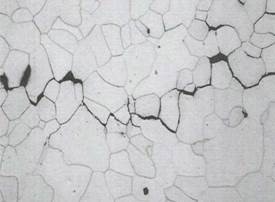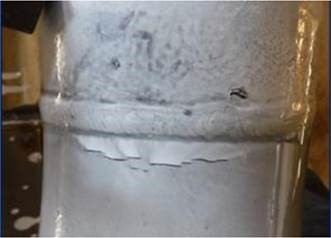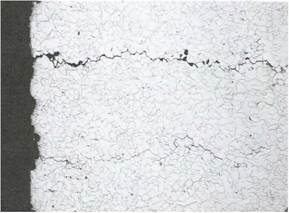- Home
- About
- Training Courses
- ASME Courses
- API Courses
- API 510 Pressure Vessel
- API 570 Process Pipework
- API 653 Aboveground Storage Tank
- API 936 Refractory Personnel
- API 580 RBI Online
- API 580 RBI Classroom *New*
- API 571 Corrosion & Materials Online
- API 571 Corrosion & Materials Classroom *New*
- API 577 Welding Inspection & Metallurgy Online
- API 510 CPD Training
- API 570 CPD Training
- API 1169 Pipeline Construction
- API SIFE Source Inspector Fixed Equipment
- API SIRE Source Inspector Rotating Equipment
- E-Learning
- Technical Courses
- API CPD Recertification
- Training Courses
- Technical Hub
- Virtual Training
- FAQs
- Contact
- Online Training Portal
- Shop

- In: Training | On: Jan 26, 2023
Methanol Stress Corrosion Cracking
When most hear the words Stress Corrosion Cracking (SCC), our minds immediately start thinking of Chloride induced SCC in stainless steels or Sulphide SCC. However, In March 2019, Step Change in Safety issued a Safety Alert about slightly less common phenomena of Methanol Stress Corrosion Cracking in Carbon Steels.
The incident occurred on an outlet line from a Methanol Storage Tank, which had been in service only approximately 18 months before developing what was observed to be a pinhole leak. Further, inspection revealed multiple leaks and weeps at cracks associated with welds in various locations throughout the low-pressure carbon steel bunkering, storage, and transfer piping.

Figure 1: Step change in safety ‘Safety Alert’ [1]
The incident begs a closer look at this damage mechanism of Methanol SCC (MSCC).
What is MSCC?
Methanol stress corrosion cracking (MSCC) is a form of corrosion caused by the combination of mechanical stress and methanol. It occurs when water is present in a methanol system constructed with a susceptible material, and the material is subject to sufficient applied and/or residual tensile stress.
The mechanism of MSCC is not very well understood. Still, it is believed to be related to the presence of water in low quantities (ca. less than 1% vol.) and other impurities in the methanol environment.
Susceptible Materials:
MSCC can occur in a wide range of materials, such as aluminium, copper alloys, stainless steel, and nickel-based alloys. It is especially prevalent in aluminium alloys, which can suffer severe cracking under the right conditions in a matter of minutes.
- Carbon steel
- Stainless steels (austenitic and duplex phase)
- Aluminium, copper, and nickel-based alloys
Critical Factors:
- Operating Temperature: High temperatures can accelerate the methanol stress corrosion cracking rate.
- Corrosive Environment: The presence of other corrosive chemicals like hydrogen sulphide, halide ions, and carbon dioxide can worsen the corrosion.
- Stress: High levels of stress (applied and/or residual) can cause the material to be more susceptible to methanol stress corrosion cracking.
- Alloy Composition: Certain alloys are more prone to methanol stress corrosion cracking than others.
- Entrained Water and Impurities: Low-quality methanol with impurities can increase the risk of methanol stress corrosion cracking. [3, 4] Role of water content in methanol is specific to a narrow range of values above which a passive metal oxide film will form, but below which the corrosion mechanism is accelerated. Water content between 0.05%-1% is the critical range in which MSCC has been found to occur. It is thought that the addition of water allows the oxide film to reform at areas where it might become damaged to due to local stresses.
- Microstructure: Different microstructures can affect the rate of methanol stress corrosion cracking.
- Chemical Properties: The chemical composition of the material can affect its susceptibility to methanol stress corrosion cracking.
For the failure reported in the Safety Alert, it was established that the combination of factors leading to these failures, was residual stress at the welds due to a lack of Post Weld Heat Treatment, and a low water content of <1%. It is important to note that welds passed the post-fabrication inspection requirements.
Of course, you can’t have MSCC without that key element of Stress. In this case, the residual stresses were introduced at the welds, via a deviation from the Weld Procedure in that Post Weld Heat Treatment was omitted. It’s at these areas of stress concentration that the oxide film is unstable, and corrosion is accelerated.
Affected Equipment:
- Heat exchangers
- Piping
- Pressure vessels
- Storage tanks
- Water treatment systems
- Heaters
- Separators
- Filters
- Connectors
Morphology or Appearance of Damage:
Methanol stress corrosion cracking (MSCC) is a type of corrosion that occurs when a combination of methanol and stress act on a susceptible material. The corrosion process is typically localised and appears as a network of small cracks that run through the material.
The morphology of MSCC depends on the material and the environment and can range from intergranular to transgranular, or both. Methanol stress corrosion cracking appears as concentric or radial cracks on the surface of the material. The cracks can be intergranular or transgranular in nature and can form in a variety of directions. The cracks may also appear as small pits, or as deep, wide grooves. The colour of the crack surface may vary from light grey to black.
The cracks can be either shallow or deep and may have a variety of shapes such as V-shaped, U-shaped, or chevron-shaped. The surface of the material may also show signs of pitting, corrosion fatigue, or other types of corrosion.

Figure 2: Intergranular stress corrosion cracking of carbon steel in industrial grade methanol (X Nital) [2]

Higher magnification (500x) [2]
The resultant cracking due to MSCC is generally intergranular in nature, and often propagates parallel to the weld, although it can also occur transversally.
Prevention / Mitigation:
So, what should be considered?
Firstly, as is often the case, a robust Risk Based Assessment should be in place, ascertaining the composition of the Methanol, specifically with regards to the water content, and reviewing the construction drawings and records to confirm whether Post Weld Heat Treatment has been carried out. The review should consider any other potential sources of residual or applied stresses, such as lack of equipment supports or misalignment etc. Then the appropriate inspection regime must be implemented, with a good probability of detection of any cracks which may have been initiated.
It is important to take preventive measures to reduce the risk of MSCC. This can include controlling the environment, such as controlling the water content and eliminating impurities from methanol. Other measures are given below:
- Use of corrosion inhibitors: The use of corrosion inhibitors such as sodium nitrite, sodium molybdate, and benzotriazole can help prevent methanol stress corrosion cracking.
- Maintaining proper pH level: Control of the pH of the methanol solution is critical to reducing the risk of methanol stress corrosion cracking. The pH should be maintained between 5 and 8.
- Reducing water concentration: Reducing the water concentration in the methanol system can help prevent methanol stress corrosion cracking.
- Temperature control: Keeping the temperature of the solution below the boiling point of methanol can help reduce the risk of methanol stress corrosion cracking.
- Avoiding high mechanical stresses: High mechanical stresses can increase the risk of methanol stress corrosion cracking. Therefore, it is important to avoid such high stresses.
- Controlling oxygen levels: Controlling the oxygen levels in the solution can help prevent methanol stress corrosion cracking. Oxygen scavengers such as sodium sulphite can be used to reduce oxygen levels.
Inspection / Monitoring:
Methanol Stress Corrosion Cracking (MSCC) is a form of corrosion that can be difficult to detect, as it occurs over a period of time and without any visible signs. It can also cause significant damage to components and systems, resulting in premature failure. To detect and prevent MSCC, non-destructive testing (NDT) techniques are used. These techniques use non-invasive methods to identify any potential defects and problems before they become serious.
To inspect for MSCC, it’s important to visually inspect the area of concern. Look for any signs of corrosion, such as pitting, discoloration, or cracking. It’s also important to inspect the area for any signs of stress, such as stress fractures, indentations, or deformations. If any signs of corrosion or stress are present, it’s important to perform further testing. This can include chemical testing, such as a methanol stress corrosion cracking test, or a metallurgical analysis to determine the cause of the corrosion.
Some of the most common NDT methods used for MSCC include the following:
- Visual Inspection: Visual inspection is one of the most used inspection techniques to monitor the presence of Methanol Stress Corrosion Cracking (MSCC). This technique involves the use of a magnifying glass to identify any signs of cracking or other damage on the surface of the metal.
- Ultrasonic Testing: Ultrasonic testing is a non-destructive method of evaluating the integrity of a material. This technique is used to detect subsurface flaws such as cracks and voids that may be caused by MSCC.
- X-Ray Diffraction: X-ray diffraction is another non-destructive method that can detect the presence and size of MSCC flaws. This technique is used to measure the crystalline structure of the metal and can provide information about the size and shape of any cracks or microstructural changes.
- Magnetic Particle Testing: Magnetic particle testing is used to detect surface and subsurface flaws in metals. This method involves the use of magnetism to locate cracks and other flaws caused by MSCC.
- Eddy Current Testing: Eddy current testing is a non-destructive method used to detect flaws in metals. This technique uses a probe to create an alternating magnetic field and measure the electrical conductivity of the material. A decrease in conductivity may indicate the presence of flaws caused by MSCC.
- Radiography Testing: Radiography testing is a non-destructive method that uses X-rays to detect flaws in metals. This technique can detect subsurface flaws such as those caused by MSCC.
- Stress Corrosion Testing: Stress corrosion testing is a destructive method used to evaluate the susceptibility of a material to MSCC. This technique involves subjecting a metal specimen to a combination of mechanical and chemical stress to induce cracking.
Each of these techniques has its own advantages and limitations, so it is important to understand which one is best suited to your application.
References.
- Step Change in Safety Bulletin Incident 4222 Failure of Carbon Steel Piping Due to Methanol Stress Corrosion Cracking, 20th March 2019
- A. Farina, U. Grassini, Stress Corrosion Cracking of Carbon Steel in Methanol, La Metallurgia Italiana, International Journal of the Italian Association for Metallurgy
- A. Farina, G. Faita and F. Olivani, Electrochemical behavior of iron in methanol and dimethylformamide solutions, Corrosion Science, Vol. 18, pp. 465 to 479, 1978
- C. Newman, Review and Hypothesis for the Stress Corrosion Mechanism of Carbon Steel in Alchools, Corrosion – Vol. 64, No 11, 2008


